

Alpine Biome. Biomes - Living Worlds. As of July 1, 2013 ThinkQuest has been discontinued.

We would like to thank everyone for being a part of the ThinkQuest global community: Students - For your limitless creativity and innovation, which inspires us all. Teachers - For your passion in guiding students on their quest. Partners - For your unwavering support and evangelism. Parents - For supporting the use of technology not only as an instrument of learning, but as a means of creating knowledge.
We encourage everyone to continue to “Think, Create and Collaborate,” unleashing the power of technology to teach, share, and inspire. Best wishes, The Oracle Education Foundation. KDE Santa Barbara. Location | Weather | Plants | Animals | People | Links LOCATION: What do you think of when you hear the word “alpine”?

Perhaps mountains or skiing? Well, you are right. Alpine biomes are found in mountain regions worldwide, including the Andes, Alps, and Rocky Mountains. The alpine biome usually lies between an altitude of about 10,000 feet (3,000 meters), and the place where the snow line of a mountain begins. WEATHER: In the summer average temperatures range from 40 to 60°F (4.5 to 15.5°C). PLANTS: The alpine biome is a tough place for plants to live. ANIMALS: Can you imagine living in a cold, windy place without much shelter? Alpine Biome. Cold, snowy, windy.
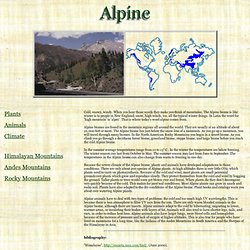
When you hear those words they make you think of mountains. The Alpine biome is like winter is to people in New England; snow, high winds, ice, all the typical winter things. In Latin the word for 'high mountain' is 'alpes'. That is where today's word alpine comes from. Alpine biomes are found in the mountain regions all around the world. In the summer average temperatures range from 10 to 15° C . Because the severe climate of the Alpine biome, plants and animals have developed adaptations to those conditions. Alpine animals have to deal with two types of problems: the cold and too much high UV wavelengths. Bibliography: "Himalayas", (June 2000). "General Ecology, EEOB 404", (June 2000). Alpine Biome. The Alpine Biome. The Alpine Biome Alpine biomes by their nature do not fit into a simple climatic scheme.
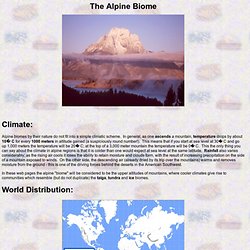
In general, as one ascends a mountain, temperature drops by about 10 C for every 1000 meters in altitude gained (a suspiciously round number!). This means that if you start at sea level at 30 C and go up 1,000 meters the temperature will be 20 C; at the top of a 3,000 meter mountain the temperature will be 0 C. This the only thing you can say about the climate in alpine regions is that it is colder than one would expect at sea level at the same latitude. Rainfall also varies considerably; as the rising air cools it loses the ability to retain moisture and clouds form, with the result of increasing precipitation on the side of a mountain exposed to winds. In these web pages the alpine "biome" will be considered to be the upper altitudes of mountains, where cooler climates give rise to communities which resemble (but do not duplicate) the taiga, tundra and ice biomes.
See Also - Boreal Forests Back. Global Environment - Biodiversity - Alpine Biome. Alpine biomes are found in the mountain regions all around the world.
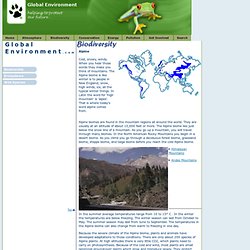
They are usually at an altitude of about 10,000 feet or more. The Alpine biome lies just below the snow line of a mountain. As you go up a mountain, you will travel through many biomes. The Alpine Biome. Welcome to Facts 4 Me display of information. The alpine biome is one of the coldest biomes on Earth.
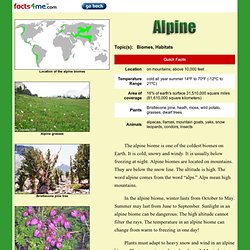
It is cold, snowy and windy. It is usually below freezing at night. Alpine biomes are located on mountains. They are below the snow line. Alpine Biome at Animal Corner. Terrestrial Biome - Alpine During the summertime, temperatures in Alpine biomes reach around 40 to 60 degrees fahrenheit, however, come winter, temperatures are well below freezing and as the altitude increases, it can get much colder.
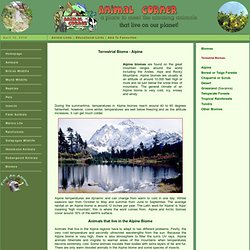
Alpine temperatures are dynamic and can change from warm to cold in one day. Winter seasons last from October to May and summer from June to September. The average rainfall on an Alpine biome is around 12 inches per year. The Latin word for 'Alpine' is 'Alps' meaning 'high mountain', this is where the word comes from. Alpine Biome. Blue Planet Biomes - World Biomes. What is a Biome?
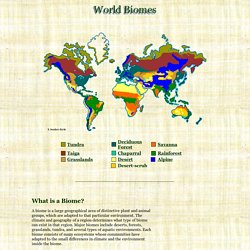
A biome is a large geographical area of distinctive plant and animal groups, which are adapted to that particular environment. The climate and geography of a region determines what type of biome can exist in that region. Major biomes include deserts, forests, grasslands, tundra, and several types of aquatic environments. Each biome consists of many ecosystems whose communities have adapted to the small differences in climate and the environment inside the biome. All living things are closely related to their environment. The earth includes a huge variety of living things, from complex plants and animals to very simple, one-celled organisms.